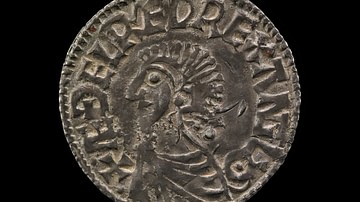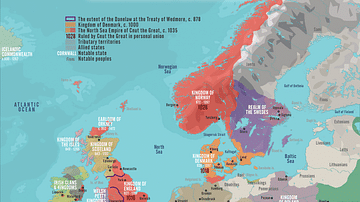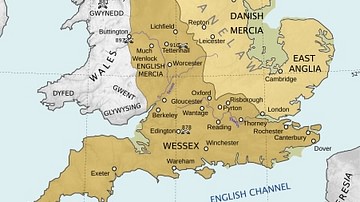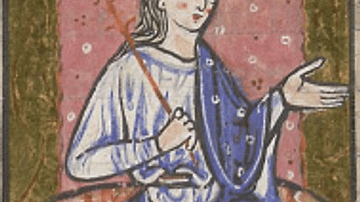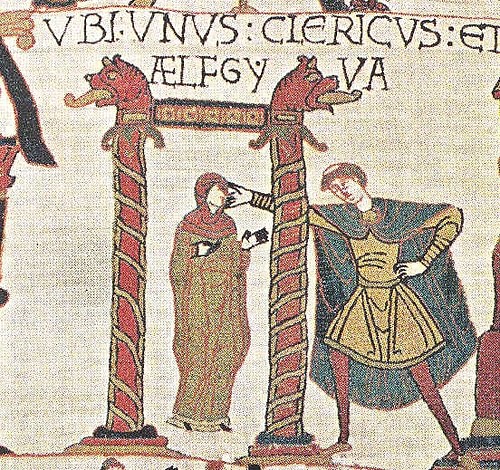
Aelfgifu of Northampton (fl. 1013-1037) was an English noble who married the English and Danish king Cnut (r. 1016-1035) and was the mother of the English king Harold I Harefoot (r. 1035-1040). Aelfgifu reached the height of her influence in the 1030s, when she governed Norway with her older son, Sweyn, and then secured Harold‘s accession to the English throne.
Early Life & Marriage to Cnut
Aelfgifu's year of birth is unknown, but she was the daughter of a prominent English ealdorman named Aelfhelm. Aelfhelm ruled the southern portions of Northumbria from 994 to 1006, during the long reign of Aethelred the Unready (r. 978-1013 and 1014-16), which was plagued by Viking invasions. In 1006, Aelfhelm was assassinated, and two of his sons were blinded on the orders of the king. Aelfgifu is not known to have endured the same kind of violence as her father and brothers, although her circumstances immediately following the upheaval are unclear.
When Sweyn Forkbeard of Denmark (r. 986-1014) invaded England in 1013 in a war of conquest, he sought out Aelfgifu as a match for his son, Cnut. Aelfgifu and Cnut most likely married sometime in 1013 or very early 1014. As a result of the Danish conquest of England, Aethelred was driven out and Sweyn became England's next king.
King Sweyn died suddenly on 3 February 1014. His Viking fleet proclaimed Cnut king, and Aelfgifu may have expected to rise even further in status as the new king's wife, but not everyone was willing to accept her and Cnut. Some of the English nobles recalled Aethelred, wishing to make him king again rather than accept Cnut as Sweyn's successor.
England to Denmark
The restored Aethelred led an army that wiped out much of Cnut's forces in Lindsey (Lincolnshire). With his support collapsing, Cnut escaped to Denmark. Aelfgifu seems to have been left behind, based on details from the Encomium Emmae Reginae, which says an unnamed English woman transported Sweyn's body from England to Denmark after Cnut had already fled. Another continental source, Thietmar of Merseburg, recounts a similar story of a nameless English woman transporting Sweyn's body overseas.
While the woman who moved Sweyn's body is not explicitly identified in these accounts, Aelfgifu is perhaps the only known English woman who had the means and authority to disinter the body of a Danish monarch and transport it directly to the royal court in Denmark. Accordingly, modern historians treat Aelfgifu of Northampton as the leading candidate for being the woman who brought Sweyn's body home.
Cnut assembled another fleet to retake England in 1015, and the war began anew. By winter 1016, Aethelred and his successor Edmund Ironside (r. 1016) were dead, making Cnut the undisputed English king at last, with Aelfgifu as his royal wife. Aelfgifu and Cnut had two children around this time, Sweyn and Harold, named after Cnut's Danish predecessors.
Two Royal Wives? Aelfgifu & Emma of Normandy
However, the union between Cnut and Aelfgifu grew far more complicated and ambiguous when Cnut married Emma of Normandy, the widow of Aethelred the Unready, in 1017. There is no evidence that Cnut's marriage to Aelfgifu was annulled or that he repudiated her, meaning he may have had two wives at once.
These royal wives would remain rivals for the rest of their lives, and they each had their own roles in Cnut's administration. Cnut would make Aelfgifu the ruler of Norway in 1030, long after he had married Emma. This is also far more authority than he ever gave to Emma. However, Emma retained the title of queen (which she also held under Aethelred), something Aelfgifu never attained, and Emma was even depicted in contemporary artwork alongside Cnut.
Aelfgifu's status after Emma entered the picture has been the subject of much debate among both medieval writers and historians. The Encomium Emmae – which Emma commissioned – tries to downgrade Aelfgifu's status. Emma had her own son with Cnut, Harthacnut, and clearly understood how much of a threat Aelfgifu posed. Her Encomium calls Aelfgifu a concubine and goes even further by saying that Cnut was not actually the father of Aelfgifu's children. But the Encomium slips up when it says Emma's children would outrank those from any "wife" or "spouse" (coniugis). Apparently, even Emma's writer knew that Aelfgifu was not a concubine.
In the 19th and 20th centuries, however, some historians followed Emma's lead and assumed that Aelfgifu was a concubine, with her children being less legitimate than Emma's. Others accepted that Cnut and Aelfgifu were married, but "in the Danish fashion" (more danico), a term that comes from Norman writer William of Jumieges. The exact nature of a marriage in "Danish fashion" – if such a thing existed – is unclear. Today, few scholars accept that Aelfgifu was a mistress or was married in a lesser "Danish fashion," which has been called a myth. Instead, some modern historians think Cnut was a bigamist. Others think that although Cnut and Aelfgifu were legitimately married, they did not live together or have more children after Emma entered the picture. Historian Timothy Bolton has also suggested a middle ground, that Aelfgifu's status was something "for which we have no satisfactory modern term" (Bolton, Ælfgifu of Northampton: Cnut the Great's Other Woman, 258).
Regardless of her exact standing, Aelfgifu remained closely associated with Cnut. Her name even appears on the Thorney Abbey Liber Vitae alongside her son Harold and the rest of the royal family, immediately after "Imma Regina" (Queen Emma).
Ruler of Norway
Not much is known of Aelfgifu's life in the 1020s, although there is a late Scandinavian reference to her controlling some territories east of Denmark along the Baltic Sea. In 1030, though, she resurfaces, with Cnut appointing her ruler of Norway. Cnut had won control of Norway in 1028, and he turned to Aelfgifu to govern it after its first regent, Haakon Ericsson (aka Håkon Eiriksson), died at sea.

Aelfgifu took along Sweyn, her older son with Cnut, who was remembered as Norway's "king" by later sagas. These sagas imply that Aelfgifu was perceived as the main ruler of Norway, though: it was recalled as "Aelfgifu's time," not Cnut or Sweyn's time, and it was remembered as an era of famine, high taxes, and harsh laws. Aelfgifu managed to hold on for five years before she and Sweyn were overthrown.
Around the same time Aelfgifu was overthrown, Sweyn died. By this point, Cnut had installed Harthacnut, his son with Emma, as king of Denmark. Aelfgifu still had her younger son, Harold Harefoot, but it is unknown what role (if any) he was given in Cnut's sprawling regime. That would change when Cnut died.
Winning the Throne for Harold
Cnut died in England in 1035, leaving behind two potential heirs, one from each wife. The powerful Earl Godwin threw his support behind Emma's son Harthacnut, but Aelfgifu was able to draw on her connections in northern England in support of Harold. Earl Leofric rallied to her cause, as did all the nobles north of the Thames and the English fleet at London. A hostile account of Aelfgifu's efforts to promote Harold is preserved in a letter to Emma's daughter Gunnhilda:
Your wretched and wicked step-mother, wishing to deprive your brother Harthacnut of the kingdom by fraud, organized a great party for all our leading men, and, eager to corrupt them at times with entreaty and at times with money, tried to subordinate them with oaths to herself and to her son.
(as quoted in the revised introduction to Encomium Emmae Reginae, ed. Alistair Campbell and Simon Keynes, p. xxxii)
Emma managed to retain Wessex on behalf of the absent Harthacnut, who was busy ruling Denmark. Emma's circle was also spreading rumors that Harold was not actually Aelfgifu and Cnut's son. In spite of this, the Anglo-Saxon Chronicle says that support was swaying heavily in Harold's favor.
Aelfgifu and Harold's faction eventually won out. Even Earl Godwin switched sides, helping Harold stop an incursion led by one of Aethelred's long-exiled sons in 1036. Harold was consecrated in 1037, putting a formal end to the dispute. King Harold had Emma exiled for good measure.
While Aelfgifu was clearly vital to Harold's accession, historian Frank Stenton went further, famously suggesting she was the "real ruler of England" during Harold's reign (421). However, Harold's reign is poorly recorded, making Stenton's assertion problematic. Harold is depicted as ruling autonomously in the sparse entries of the Anglo-Saxon Chronicle, as well as in one of the only surviving documents from his reign, known as S 1467. There is one possible reference to Aelfgifu during Harold's reign, though – a bishop's will that references "my lady" in association with King Harold, although it is unclear whether this is a reference to Aelfgifu or an unknown wife of Harold's. Given the scarcity of surviving material from the reign, it is hard to say what role Aelfgifu played in her son's administration, although she had clearly been essential to his accession.
Harold's Death & Aftermath
Harold died in 1040, paving the way for Harthacnut to finally ascend to the English throne. Harthacnut made a ghoulish display of his predecessor, having Harold's body disinterred, executed, and thrown into the Thames. It is not known what happened to Aelfgifu after Harold's death.
However, there may be two final references to her. A son of Harold Harefoot, Aelfwine, is mentioned as an abbot in Aquitaine in 1060 and 1062, and Aelfwine is said to have been born in London to an Aelfgifu. This "Aelfgifu" could be the name of Harold's wife or mistress, although it has also been suggested that this is a mistaken reference to Aelfgifu of Northampton, who would have been Aelfwine's grandmother. This at least raises the possibility that Aelfgifu of Northampton went into exile in southern France at some point. It has also been argued that the mysterious Aelfgifu of the Bayeux Tapestry, describing the events of the Norman conquest of England in 1066, is Aelfgifu of Northampton. Even with these possibilities in mind, it is hard to say anything of certainty about Aelfgifu's life after Harold Harefoot's reign.
A Divisive Figure
Medieval sources are often hostile to Aelfgifu, such as how she appears as a stereotypical wicked stepmother in the letter to Gunnhilda or as an unscrupulous concubine who deceived Cnut in the Encomium. She was remembered as an oppressive foreign master by the Norwegians.
However, other sources are neutral towards Aelfgifu. Various versions of the Anglo-Saxon Chronicle mention her during the succession crisis of 1035-37 but do not pass judgment on her. The bishop's will from Harold's reign, if it does indeed refer to Aelfgifu, lists her respectfully as "my lady," worthy of bequests. If the Aquitaine source is referring to Aelfgifu, this is another dispassionate reference to her. That said, with no one to write explicitly in her favor, this powerful noblewoman attracted attacks from several different angles that largely went unanswered.
Aelfgifu has remained controversial in modern times, too. Eric John once called her a "total disaster" (162) while W. H. Stevenson considered her "stronger and more ruthless" than Emma (114). True to Stevenson's summary, it is hard to view Aelfgifu without comparison to Emma, perhaps because these ambitious figures had much in common. They were, after all, married to the same man and had the same basic goal of securing their son's succession to the throne. The main difference between the two may simply be that Emma had the benefit of someone writing in her honor, whereas Aelfgifu did not.




